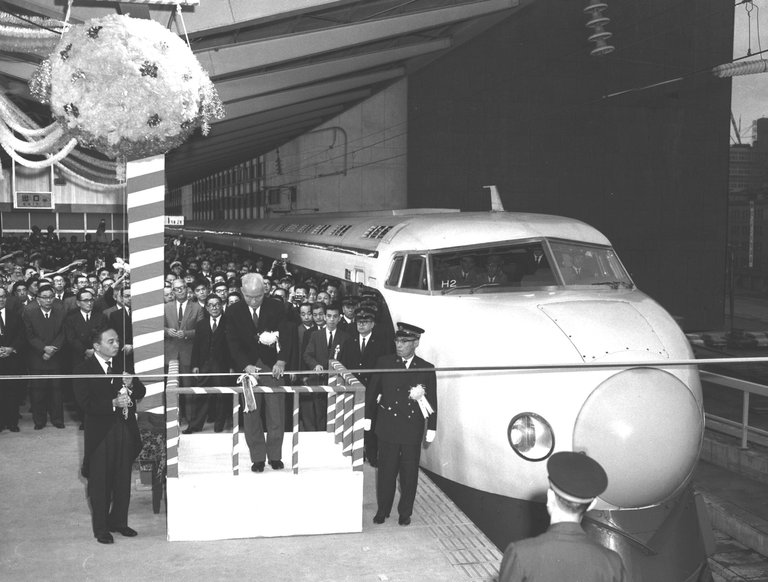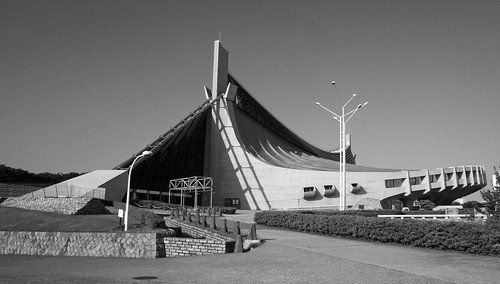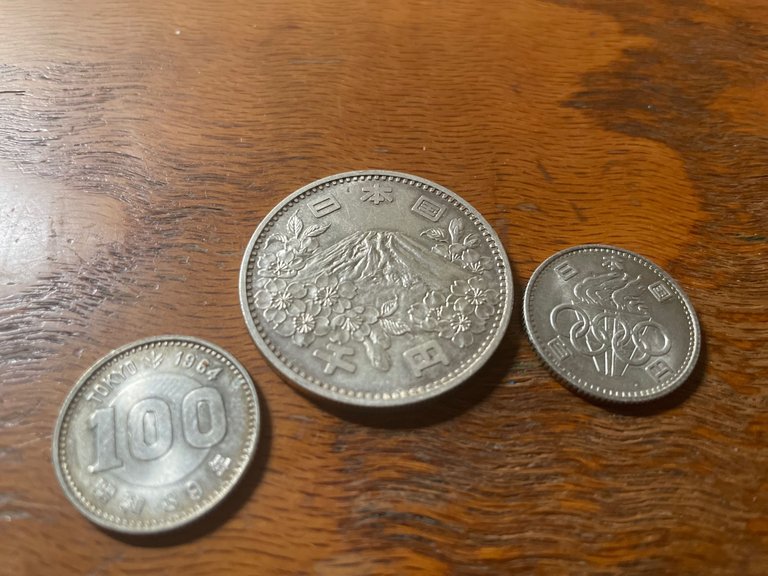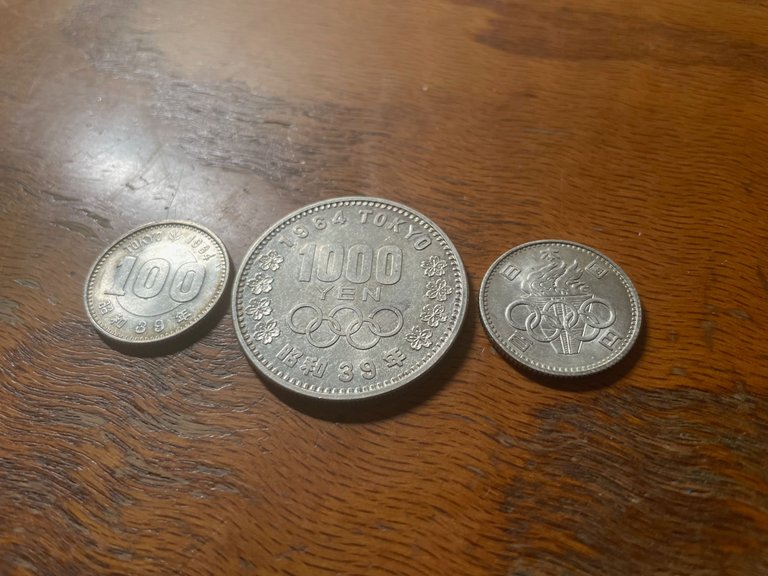The First Olympics in Japan
1964 was an important year for Japan. The Olympics were set to be in Tokyo and Japan used the occasion as a chance to reintroduce themselves to the world and redesign its image in a much more positive light, from war-torn devastation to beacon of innovation. As I mentioned in yesterday's post, Japan's crazy future technology was on full display.
Train of the Future: The Shinkansen
One of the star attractions was the introduction of the Shinkansen, or the Bullet Train. Launching just days before the Olympics, it connected Tokyo with Osaka, Japan’s two largest cities, at unprecedented speeds. The Shinkansen symbolized Japan’s post-war resurgence and engineering ingenuity, showcasing an ability to blend speed, safety, and service, reshaping perceptions of train travel globally.

Broadcasting Breakthroughs: Color TV and Live Satellite Feeds
Another technological leap was the advent of live color broadcasts of the Olympics, a novelty at the time that brought the vibrancy of the games into homes around the world. This was Japan’s first use of satellite technology for broadcasting, which not only enhanced viewer experience but also demonstrated Japan’s capabilities in emerging telecommunication technologies. Magic!
Architectural Ingenuity: The Yoyogi National Gymnasium
The games also saw the construction of avant-garde facilities such as the Yoyogi National Gymnasium, designed by the renowned architect Kenzo Tange. Its innovative design and use of suspended roof structures became a highlight of modernist architecture in Japan, serving as a testament to the country’s design and architectural sophistication, seriously impressing the athletes and spectators alike.

The Digital Revolution: Crazy Future Computer Technology at the Forefront
The use of advanced computer systems was a game-changer at the Olympics. For the first time, computers were employed to manage everything from event scheduling to real-time results dissemination, using futuristic electronic scoreboards. This not only streamlined operations but also solidified Japan’s reputation as a frontrunner in the burgeoning field of computer technology, cementing Japan's image as a technology paradise, an image that largely persists to this very day.
Commemorative Currency: A Numismatic Celebration
In celebration of the Olympics, Japan minted two commemorative coins—a ¥100 and a ¥1000 coin. While intended for circulation, their quick uptake by collectors limited their availability. The ¥100 coin, comprising 60% silver, and the ¥1000 coin, made of 92.5% silver, feature designs that reflect Japanese culture and achievements. The ¥100 isn't much to look at, but its bigger brother is pretty attractive, with that stunning depiction of Mount Fuji.


These days you can find both of them easily enough. The ¥100 is fairly common and can be had from many collectors for only a little. The ¥1000 is also pretty common—again, these were intended for circulation, so plenty of them were minted—but collectors do try to hike up the price for that one. When I look on ebay, I'm shocked at what some people are trying to get for it.

These technological advancements and cultural exhibitions during the 1964 Tokyo Olympics not only transformed Japan’s global image but also set a new standard for how technology could enhance and influence global events. The legacy of these games continues to influence Olympic hosting standards, proving that the 1964 Tokyo Olympics were not just a sporting event but a pivotal moment in Japan’s modern history.
A far cry from today's games which seem to have only succeeded in many people fight about the chromosomes some of the participants have. Oh well. At least we can look back to when the Olympics really were something to behold.
❦
 |
David LaSpina is an American photographer and translator lost in Japan, trying to capture the beauty of this country one photo at a time and searching for the perfect haiku. He blogs here and at laspina.org. Write him on Twitter or Mastodon. |
You received an upvote of 100% from Precious the Silver Mermaid!
Thank you for contributing more great content to the #SilverGoldStackers tag.
You have created a Precious Gem!
I can't believe the bullet train is so old. How fast does it go? Is it still in operation today? Meanwhile over here trains can't go over 30 mph!
160–200 mph. There is a new maglev bullet train being developed that gets up to 375 mph. I think that original one in the photo was retired a few years ago.
Dang, that is awesome!
Very interesting read and piece of history @dbooster. That is really something how the Olympics was a coming out party for Japan of sorts. Those are some cool designs, especially on the 1000 yen.
Yeah, it's a nice coin!
👏 Keep Up the good work on Hive ♦️ 👏
❤️ @bhattg suggested sagarkothari88 to upvote your post ❤️
🙏 Don't forget to Support Back 🙏
I've certainly learnt something
Good to hear!
I really feel for Japan hosting the last Olympics ruined by a damn virus. I'm sure if it were held under normal times, the Japanese would have done another sterling job as they have proved they can deliver back in 1964
That Olympics was already kind of a mess even before COVID to be honest. Most of the Japanese people didn't want it, but Abe forced it through, despite all the jokes in the country mocking him for only doing it because he desperately wanting to be like his grandpa (prime minister kishi).
That said, yeah they probably would have done a much better job had it not been for the virus.
I didn't know about his grandpa's story. I just remember him appearing at the closing ceremony at Rio as Mario. Sad end to his life.
!pimp !hiqvote
You must be killin' it out here!
@trumpman just slapped you with 1.000 PIMP, @dbooster.
You earned 1.000 PIMP for the strong hand.
They're getting a workout and slapped 1/3 possible people today.
Read about some PIMP Shit or Look for the PIMP District
@trumpman, the HiQ Smart Bot has recognized your request (1/3) and will start the voting trail.
In addition, @dbooster gets !PIZZA from @hiq.redaktion.
For further questions, check out https://hiq-hive.com or join our Discord. And don't forget to vote HiQs fucking Witness! 😻
I need them coins !DOOK !BBH !PIMP
You just got DOOKed!
@bitcoinman thinks your content is the shit.
They have 29/400 DOOK left to drop today.
Learn all about this shit in the toilet paper! 💩
You must be killin' it out here!
@bitcoinman just slapped you with 10.000 PIMP, @dbooster.
You earned 10.000 PIMP for the strong hand.
They're getting a workout and slapped 3/3 possible people today.
Read about some PIMP Shit or Look for the PIMP District
@dbooster! @bitcoinman likes your content! so I just sent 1 BBH to your account on behalf of @bitcoinman. (12/50)
(html comment removed: )
)